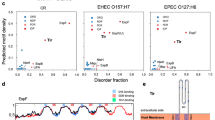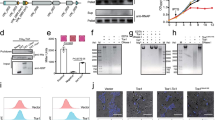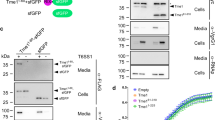Abstract
Type 3 secretion systems (T3SSs) of bacterial pathogens translocate bacterial effector proteins that mediate disease into the eukaryotic cytosol. Effectors traverse the plasma membrane through a translocon pore formed by T3SS proteins. In a genome-wide selection, we identified the intermediate filament vimentin as required for infection by the T3SS-dependent pathogen S. flexneri. We found that vimentin is required for efficient T3SS translocation of effectors by S. flexneri and other pathogens that use T3SS, Salmonella enterica serovar Typhimurium and Yersinia pseudotuberculosis. Vimentin and the intestinal epithelial intermediate filament keratin 18 interact with the C-terminus of the Shigella translocon pore protein IpaC. Vimentin and its interaction with IpaC are dispensable for pore formation, but are required for stable docking of S. flexneri to cells; moreover, stable docking triggers effector secretion. These findings establish that stable docking of the bacterium specifically requires intermediate filaments, is a process distinct from pore formation, and is a prerequisite for effector secretion.
This is a preview of subscription content, access via your institution
Access options
Subscribe to this journal
Receive 12 digital issues and online access to articles
$119.00 per year
only $9.92 per issue
Buy this article
- Purchase on Springer Link
- Instant access to full article PDF
Prices may be subject to local taxes which are calculated during checkout






Similar content being viewed by others
References
Galan, J. E., Lara-Tejero, M., Marlovits, T. C. & Wagner, S. Bacterial type III secretion systems: specialized nanomachines for protein delivery into target cells. Annu. Rev. Microbiol. 68, 415–438 (2014).
Galan, J. E. & Wolf-Watz, H. Protein delivery into eukaryotic cells by type III secretion machines. Nature 444, 567–573 (2006).
Cheung, M. et al. Three-dimensional electron microscopy reconstruction and cysteine-mediated crosslinking provide a model of the type III secretion system needle tip complex. Mol. Microbiol. 95, 31–50 (2015).
Kubori, T. et al. Supramolecular structure of the Salmonella typhimurium type III protein secretion system. Science 280, 602–605 (1998).
Menard, R., Sansonetti, P. & Parsot, C. The secretion of the Shigella flexneri Ipa invasins is activated by epithelial cells and controlled by IpaB and IpaD. EMBO J. 13, 5293–5302 (1994).
Veenendaal, A. K. et al. The type III secretion system needle tip complex mediates host cell sensing and translocon insertion. Mol. Microbiol. 63, 1719–1730 (2007).
Blocker, A. et al. The tripartite type III secreton of Shigella flexneri inserts IpaB and IpaC into host membranes. J. Cell Biol. 147, 683–693 (1999).
Kenjale, R. et al. The needle component of the type III secreton of Shigella regulates the activity of the secretion apparatus. J. Biol. Chem. 280, 42929–42937 (2005).
Meghraoui, A., Schiavolin, L. & Allaoui, A. Single amino acid substitutions on the needle tip protein IpaD increased Shigella virulence. Microbes Infect. 16, 532–539 (2014).
Schiavolin, L. et al. Functional insights into the Shigella type III needle tip IpaD in secretion control and cell contact. Mol. Microbiol. 88, 268–282 (2013).
Stamm, L. M. & Goldberg, M. B. Microbiology. Establishing the secretion hierarchy. Science 331, 1147–1148 (2011).
Lara-Tejero, M., Kato, J., Wagner, S., Liu, X. & Galan, J. E. A sorting platform determines the order of protein secretion in bacterial type III systems. Science 331, 1188–1191 (2011).
Misselwitz, B. et al. Salmonella enterica serovar Typhimurium binds to HeLa cells via Fim-mediated reversible adhesion and irreversible type three secretion system 1-mediated docking. Infect. Immun. 79, 330–341 (2011).
Lara-Tejero, M. & Galan, J. E. Salmonella enterica serovar typhimurium pathogenicity island 1-encoded type III secretion system translocases mediate intimate attachment to nonphagocytic cells. Infect. Immun. 77, 2635–2642 (2009).
Nhieu, G. T. & Sansonetti, P. J. Mechanism of Shigella entry into epithelial cells. Curr. Opin. Microbiol. 2, 51–55 (1999).
Ogawa, M. & Sasakawa, C. Intracellular survival of Shigella. Cell. Microbiol. 8, 177–184 (2006).
Tran Van Nhieu, G., Ben-Ze'ev, A. & Sansonetti, P. J. Modulation of bacterial entry into epithelial cells by association between vinculin and the Shigella IpaA invasin. EMBO J. 16, 2717–2729 (1997).
Mounier, J. et al. Rho family GTPases control entry of Shigella flexneri into epithelial cells but not intracellular motility. J. Cell Sci. 112(Pt 13), 2069–2080 (1999).
Handa, Y. et al. Shigella IpgB1 promotes bacterial entry through the ELMO-Dock180 machinery. Nature Cell Biol. 9, 121–128 (2007).
Hachani, A. et al. IpgB1 and IpgB2, two homologous effectors secreted via the Mxi-Spa type III secretion apparatus, cooperate to mediate polarized cell invasion and inflammatory potential of Shigella flexenri. Microbes Infect. 10, 260–268 (2008).
Garza-Mayers, A. C., Miller, K. A., Russo, B. C., Nagda, D. V. & Goldberg, M. B. Shigella flexneri regulation of ARF6 activation during bacterial entry via an IpgD-mediated positive feedback loop. MBio 6, e02584 (2015).
Carette, J. E. et al. Haploid genetic screens in human cells identify host factors used by pathogens. Science 326, 1231–1235 (2009).
Carette, J. E. et al. Ebola virus entry requires the cholesterol transporter Niemann–Pick C1. Nature 477, 340–343 (2011).
Bernardini, M. L., Mounier, J., d'Hauteville, H., Coquis-Rondon, M. & Sansonetti, P. J. Identification of icsA, a plasmid locus of Shigella flexneri that governs bacterial intra- and intercellular spread through interaction with F-actin. Proc. Natl Acad. Sci. USA 86, 3867–3871 (1989).
Ivaska, J., Pallari, H. M., Nevo, J. & Eriksson, J. E. Novel functions of vimentin in cell adhesion, migration, and signalling. Exp. Cell Res. 313, 2050–2062 (2007).
Eriksson, J. E. et al. Introducing intermediate filaments: from discovery to disease. J. Clin. Invest. 119, 1763–1771 (2009).
Mor-Vaknin, N. et al. Murine colitis is mediated by vimentin. Sci. Rep. 3, 1045 (2013).
Colucci-Guyon, E. et al. Mice lacking vimentin develop and reproduce without an obvious phenotype. Cell 79, 679–694 (1994).
Chu, P. G. & Weiss, L. M. Keratin expression in human tissues and neoplasms. Histopathology 40, 403–439 (2002).
Jepson, M. A., Mason, C. M., Bennett, M. K., Simmons, N. L. & Hirst, B. H. Co-expression of vimentin and cytokeratins in M cells of rabbit intestinal lymphoid follicle-associated epithelium. Histochem. J. 24, 33–39 (1992).
Leube, R. E., Moch, M. & Windoffer, R. Intermediate filaments and the regulation of focal adhesion. Curr. Opin. Cell Biol. 32, 13–20 (2015).
Mor-Vaknin, N., Punturieri, A., Sitwala, K. & Markovitz, D. M. Vimentin is secreted by activated macrophages. Nature Cell Biol. 5, 59–63 (2003).
Zou, Y., He, L. & Huang, S. H. Identification of a surface protein on human brain microvascular endothelial cells as vimentin interacting with Escherichia coli invasion protein IbeA. Biochem. Biophys. Res. Commun. 351, 625–630 (2006).
Picking, W. L. et al. Identification of functional regions within invasion plasmid antigen C (IpaC) of Shigella flexneri. Mol. Microbiol. 39, 100–111 (2001).
Harrington, A. et al. Characterization of the interaction of single tryptophan containing mutants of IpaC from Shigella flexneri with phospholipid membranes. Biochemistry 45, 626–636 (2006).
Kuwae, A. et al. Shigella invasion of macrophage requires the insertion of IpaC into the host plasma membrane. Functional analysis of IpaC. J. Biol. Chem. 276, 32230–32239 (2001).
Scherer, C. A., Cooper, E. & Miller, S. I. The Salmonella type III secretion translocon protein SspC is inserted into the epithelial cell plasma membrane upon infection. Mol. Microbiol. 37, 1133–1145 (2000).
Carlson, S. A., Omary, M. B. & Jones, B. D. Identification of cytokeratins as accessory mediators of Salmonella entry into eukaryotic cells. Life Sci. 70, 1415–1426 (2002).
Schmitz, A. M., Morrison, M. F., Agunwamba, A. O., Nibert, M. L. & Lesser, C. F. Protein interaction platforms: visualization of interacting proteins in yeast. Nature Methods 6, 500–502 (2009).
Terry, C. M. et al. The C-terminus of IpaC is required for effector activities related to Shigella invasion of host cells. Microb. Pathog. 45, 282–289 (2008).
Kwuan, L., Adams, W. & Auerbuch, V. Impact of host membrane pore formation by the Yersinia pseudotuberculosis type III secretion system on the macrophage innate immune response. Infect. Immun. 81, 905–914 (2013).
Viboud, G. I. & Bliska, J. B. Measurement of pore formation by contact-dependent type III protein secretion systems. Methods Enzymol. 358, 345–350 (2002).
Viboud, G. I. & Bliska, J. B. A bacterial type III secretion system inhibits actin polymerization to prevent pore formation in host cell membranes. EMBO J. 20, 5373–5382 (2001).
Reeves, A. Z. et al. Engineering Escherichia coli into a protein delivery system for mammalian cells. ACS Synth. Biol. 4, 644–654 (2015).
Vanaja, S. K., Rathinam, V. A. & Fitzgerald, K. A. Mechanisms of inflammasome activation: recent advances and novel insights. Trends Cell Biol. 25, 308–315 (2015).
Shi, J. et al. Inflammatory caspases are innate immune receptors for intracellular LPS. Nature 514, 187–192 (2014).
Dos Santos, G. et al. Vimentin regulates activation of the NLRP3 inflammasome. Nature Commun. 6, 6574 (2015).
Batchelor, M. et al. Involvement of the intermediate filament protein cytokeratin-18 in actin pedestal formation during EPEC infection. EMBO Rep. 5, 104–110 (2004).
Campbell-Valois, F. X. et al. A fluorescent reporter reveals on/off regulation of the Shigella type III secretion apparatus during entry and cell-to-cell spread. Cell Host Microbe 15, 177–189 (2014).
Picking, W. L. et al. IpaD of Shigella flexneri is independently required for regulation of Ipa protein secretion and efficient insertion of IpaB and IpaC into host membranes. Infect. Immun. 73, 1432–1440 (2005).
Roehrich, A. D., Guillossou, E., Blocker, A. J. & Martinez-Argudo, I. Shigella IpaD has a dual role: signal transduction from the type III secretion system needle tip and intracellular secretion regulation. Mol. Microbiol. 87, 690–706 (2013).
Labrec, E. H., Schneider, H., Magnani, T. J. & Formal, S. B. Epithelial cell penetration as an essential step in the pathogenesis of bacillary dysentery. J. Bacteriol. 88, 1503–1518 (1964).
Maurelli, A. T., Baudry, B., d'Hauteville, H., Hale, T. L. & Sansonetti, P. J. Cloning of plasmid DNA sequences involved in invasion of HeLa cells by Shigella flexneri. Infect. Immun. 49, 164–171 (1985).
Menard, R., Sansonetti, P. J. & Parsot, C. Nonpolar mutagenesis of the ipa genes defines IpaB, IpaC, and IpaD as effectors of Shigella flexneri entry into epithelial cells. J. Bacteriol. 175, 5899–5906 (1993).
Russo, B. C. et al. A Francisella tularensis locus required for spermine responsiveness is necessary for virulence. Infect. Immun. 79, 3665–3676 (2011).
Labigne-Roussel, A. F., Lark, D., Schoolnik, G. & Falkow, S. Cloning and expression of an afimbrial adhesin (AFA-I) responsible for P blood group-independent, mannose-resistant hemagglutination from a pyelonephritic Escherichia coli strain. Infect. Immun. 46, 251–259 (1984).
Carette, J. E. et al. Global gene disruption in human cells to assign genes to phenotypes by deep sequencing. Nature Biotechnol. 29, 542–546 (2011).
Reimand, J., Arak, T. & Vilo, J. g:Profiler--a web server for functional interpretation of gene lists (2011 update). Nucleic Acids Res. 39, W307–W315 (2011).
Heindl, J. E., Saran, I., Yi, C. R., Lesser, C. F. & Goldberg, M. B. Requirement for formin-induced actin polymerization during spread of Shigella flexneri. Infect. Immun. 78, 193–203 (2010).
Costa, S. C. & Lesser, C. F. A multifunctional region of the Shigella type 3 effector IpgB1 is important for secretion from bacteria and membrane targeting in eukaryotic cells. PLoS ONE 9, e93461 (2014).
Bahrani, F. K., Sansonetti, P. J. & Parsot, C. Secretion of Ipa proteins by Shigella flexneri: inducer molecules and kinetics of activation. Infect. Immun. 65, 4005–4010 (1997).
Soyer, M. & Dumenil, G. A laminar-flow chamber assay for measuring bacterial adhesion under shear stress. Methods Mol. Biol. 799, 185–195 (2012).
Mikaty, G. et al. Extracellular bacterial pathogen induces host cell surface reorganization to resist shear stress. PLoS Pathog. 5, e1000314 (2009).
Moreau-Marquis, S. et al. The ΔF508-CFTR mutation results in increased biofilm formation by Pseudomonas aeruginosa by increasing iron availability. Am. J. Physiol. Lung Cell. Mol. Physiol. 295, L25–L37 (2008).
Muller, N. F. et al. Trimeric autotransporter adhesin-dependent adherence of Bartonella henselae, Bartonella quintana, and Yersinia enterocolitica to matrix components and endothelial cells under static and dynamic flow conditions. Infect. Immun. 79, 2544–2553 (2011).
Yi, C. R. et al. Systematic analysis of bacterial effector-postsynaptic density 95/disc large/zonula occludens-1 (PDZ) domain interactions demonstrates Shigella OspE protein promotes protein kinase C activation via PDLIM proteins. J. Biol. Chem. 289, 30101–30113 (2014).
Costa, S. C. et al. A new means to identify type 3 secreted effectors: functionally interchangeable class IB chaperones recognize a conserved sequence. MBio 3, e00243-11 (2012).
Baxt, L. A. & Goldberg, M. B. Host and bacterial proteins that repress recruitment of LC3 to Shigella early during infection. PLoS ONE 9, e94653 (2014).
Sievers, F. & Higgins, D. G. Clustal omega. Curr. Protoc. Bioinformatics 48, 3.13.11–13.13.16 (2014).
Acknowledgements
We thank Victor Faundez, Cammie Lesser, Wendy Picking and William Picking, Joan Mecsas, Victoria Auerbuch-Stone, Beth McCormick and Ana Maldonado-Contreras, and Claude Parsot for cell lines, bacterial strains, reagents, technical assistance and protocols, Alexandra Wiscovitch for technical assistance, and Matthew Brown for critical reading of the manuscript. This work was funded by National Institutes of Health (NIH) RO1 AI081724 (to M.B.G.), NIH T32 AI007061 (to B.C.R.), NIH F32 AI092967 (to L.A.B.), NIH F32 AI114162 (to B.C.R.), a career development award through the New England Regional Center of Excellence in Biodefense and Emerging Infectious Disease and the Institute of Chemistry and Cell Biology (ICCB)-Longwood Facility at Harvard Medical School (NIH U54 AI057159, to L.M.S.), and the Coordination for the Improvement of Higher Education Personnel (CAPES) Foundation, Ministry of Education of Brazil, Brasilia-DF, 70040-020, Brazil (to A.L.Q.).
Author information
Authors and Affiliations
Contributions
B.C.R., M.B.G., and L.M.S. wrote the manuscript. B.C.R., M.B.G., L.M.S., M.R., S.P.W., and L.A.B. designed experiments and interpreted data. B.C.R., L.M.S., M.R., L.R.R., A.L.Q., B.B.H., L.A.B., C.M.K., S.B., G.M., E.K., L.R., Y.F., and N.M-V. performed experiments. All authors discussed the results and commented on the manuscript.
Corresponding author
Ethics declarations
Competing interests
The authors declare no competing financial interests.
Supplementary information
Supplementary Information
Supplementary Table 2, Figures 1-15 and References. (PDF 2842 kb)
Supplementary Table 1
Significantly enriched genes identified by selection. (XLSX 31 kb)
Rights and permissions
About this article
Cite this article
Russo, B., Stamm, L., Raaben, M. et al. Intermediate filaments enable pathogen docking to trigger type 3 effector translocation. Nat Microbiol 1, 16025 (2016). https://doi.org/10.1038/nmicrobiol.2016.25
Received:
Accepted:
Published:
DOI: https://doi.org/10.1038/nmicrobiol.2016.25
This article is cited by
-
Salmonella effector SopB reorganizes cytoskeletal vimentin to maintain replication vacuoles for efficient infection
Nature Communications (2023)
-
Type three secretion system in Salmonella Typhimurium: the key to infection
Genes & Genomics (2020)
-
Assembly, structure, function and regulation of type III secretion systems
Nature Reviews Microbiology (2017)



